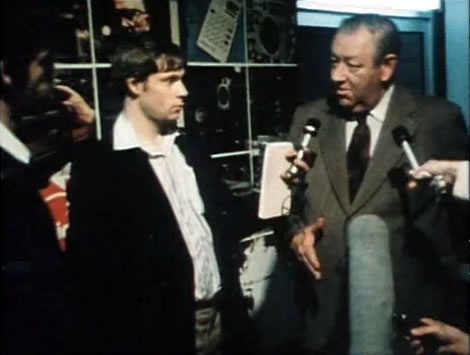
Colin McLachlan, Minister of Civil Aviation, talks to reporters on the night of the Erebus disaster, just after it was confirmed that the aircraft would now be out of fuel.
Out of fuel
Waiting for news
Mark Benney describes the fortitude of relatives waiting for news of the Erebus flight at Auckland airport. Read more about this sound file.
If they hadn't already heard the news, friends and family arriving at Māngere airport to meet passengers from Air New Zealand's Flight TE901 quickly learnt that something was wrong – the arrivals board directed them to 'check with airline'. At 9.05 p.m. NZDT*, around the time Air New Zealand made its first statement on the flight, they were moved to the Auckland Regional Authority's conference room. Here airport manager Don Murray broke the news that the situation was 'not quite normal'; the aircraft had been radio silent for a number of hours and would have just run out of fuel. Like their counterparts in Christchurch, they were provided with refreshments; a priest later arrived to comfort them.
At about 9.30, by which time the aircraft would have been out of fuel for over half an hour, Air New Zealand headquarters received a phone call from Christchurch confirming that it had still not arrived. Shortly before 10 p.m. the airline's public affairs director, Craig Saxon, issued a statement:
It is with great regret that we must accept that the aircraft is lost. It is assumed that the aircraft must be down.
This statement, reported on the radio and in South Pacific Television's News at 10, is the last information many people would have heard about the flight before they went to bed.
At this point there was still hope that there could be survivors of a crash. In his statement, Craig Saxon emphasised that there was extensive life-support equipment on the aircraft. Shortly afterwards, Minister of Civil Aviation Colin McLachlan spoke about the search and rescue efforts that had been launched. He was at Christchurch airport waiting to talk to the crew of the US Air Force Starlifter that was searching along TE901's proposed flight track.
At around 10.30 the Starlifter arrived in Christchurch. The pilot, Major Bruce Gumble, reported that he hadn't heard from TE901's flight crew for some time before his landing at McMurdo. To the dismay of those waiting, he also advised that his crew had seen nothing of the aircraft on their return flight. From 11 p.m. the replacement crew, family and friends left the airports to wait at home for further news.
In Antarctica, unsuccessful search efforts continued. The US Navy's LC-130, XD-01, continued to search, while the two UH-1N helicopters, Gentle 14 and 17, returned to base to refuel before resuming their searches. At 10.03 p.m. NZST another LC-130, XD-03, began searching high ground to the south of Ross Island.
Hope faded as the night went on. In an interview at approximately midnight NZDT, Air New Zealand chief executive Morrie Davis was asked whether there was any hope of passengers surviving. He responded:
Clearly, it is a question one would like to answer in the positive. But I must say the circumstances indicate any chance is a very slim one.
*On the day of the Erebus disaster there was a one-hour time difference between New Zealand and McMurdo Station. McMurdo Station was operating under New Zealand Standard Time (NZST), while New Zealand was operating under daylight saving or New Zealand Daylight Time (NZDT). Scott Base and McMurdo Station did not begin observing daylight saving until the summer of 1992/93.
Part of: Hearing the news
Next page: Wreckage sighted



Community contributions